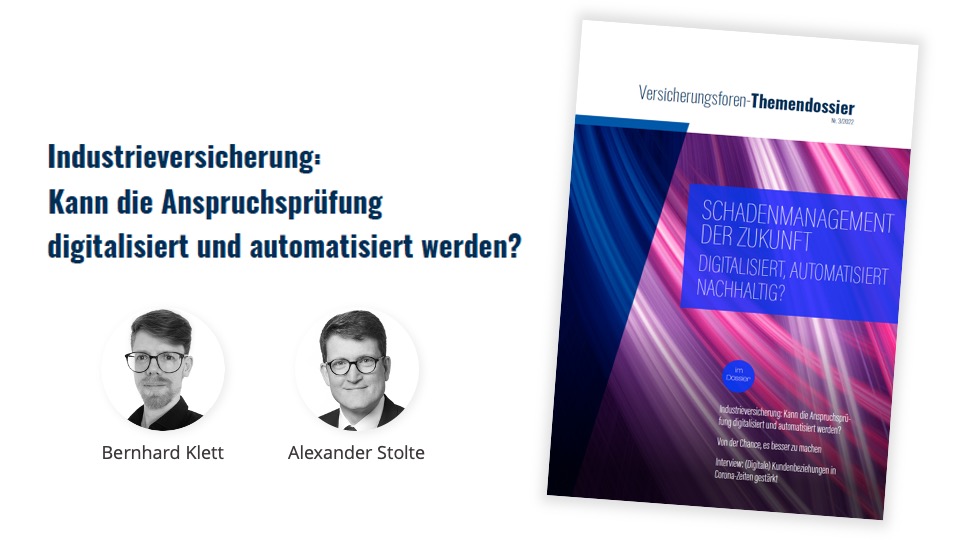Industrial insurance, that means complex coverages and contracts. Digital claims management and digital claims validation are not yet standard for industrial insurers. A central challenge is to make the heterogeneous contract landscape manageable, especially in claims processing.
This is an excerpt from the Themendossier 03/2022 of Versicherungsforen Leipzig. Read the full article in german language here.
Which processes in claims management can be automated and where are the limits?
Claims management in industrial insurance is faced with the task of identifying the right basis for claims, even in complex contracts and claims.
If we wanted to design a process in such a way that it could not be digitised, it would probably look like this:
- It would not be rule-based and would not follow a fixed pattern.
- Relevant information would only exist in the heads of individuals.
- Data would only exist in an unstructured form that could not be read by systems, i.e. as scanned documents or as free text.
- There would be no exchange of information between systems.
- Conflicting data existed.
- Departments always acted separately from each other and persistently maintained their isolated solutions.
Absurd scenario? Not at all. A large part of claims processing in industrial insurance takes place in exactly the same way today.
Identifying the basis for claims
Practical example
A client reports an environmental liability claim. Finding the basis for the claim is a challenge because the client is a subsidiary. Is the client covered by the parent company’s basic contract or is there a separate contract? The basic contract is public liability – does that also include environmental liability?
Such clarifications are part of the daily routine of claims handlers in industrial insurance.
Prerequisites for digital claim validation
The system must be able to understand which data is used as input in order to process the claim validation in a rule-based manner and arrive at a result.
To make complex cover manageable, the contract must be structured accordingly. For contracts that include a wide variety of risks, it makes sense to divide the contract into coverage modules.
Cover validation
Basically, we distinguish between policy validation (formal check) and claims validation (substantial check) verification.
Policy validation
- Is the building insured under the contract at the time of loss?
- Does the contract basically cover the type of loss reported?
- Have all premiums been paid or is the contract in default proceedings?
Claims validation
- How extensive is the damage?
- Does the wording cover the damage?
- Is an expert opinion required?
- Is there a case of fraud?
In a digital claims validation check, relevant data is compiled and presented in a clear form for the user. This not only saves time, but also provides a technical framework that even inexperienced claims handlers can work along.
Frequent and major losses
The insurer has the responsibility to process all claims appropriately. However, claims vary considerably in their complexity, as well as the costs and benefits associated with manual processing. For optimal claims handling, the process must fit the type of claim.
For frequency claims, with their simpler structure, you want to have a lean process or process the claims directly based on rules. Due to the low level of damage, any inaccuracies in the dark processing remain without major consequences and are more than outweighed by time savings. Quality control can be carried out on a random basis through the manual processing of individual claims, or through monitoring, which monitors the efficiency of the process as a whole.
In contrast to this are the major claims. These can have an impact on the insurer’s balance sheet and become very complex. It is important to avoid costly mistakes and to make the right settlement decision. Time savings play a subordinate role, unlike with frequency claims.
Large claims are also characterised by the fact that experts, surveyors, lawyers and others are involved in the claims process. Cooperation with these partners cannot be automated. It is similar with the settlement decision of a complex claim. On the one hand, there is no data basis to train an artificial intelligence, and on the other hand, the decision must be well-founded, which AI systems are still unable to do. For these reasons, technical support is essentially limited to integrating partners into the process and exchanging information. Simplified, automated processing as in the case of frequency damage is out of place here. Instead, a thorough, largely manual process based on the expertise of the claims handlers is needed.
Conclusion
Currently, automated claims review mostly consists of compiling data and processing it in a rule-based manner. It can make a significant contribution to higher effectiveness and efficiency of claims management.
If you want to go beyond this and avoid the pitfalls mentioned at the beginning, you should already ask yourself at the product design stage what the associated digital process could look like. If terms and conditions, coverages and agreements with the contractual partners are already fixed before thoughts about automated processing can flow in, little will improve the current situation.
So if you want to exploit the possibilities of digitalisation, you have to think about claims processing from the product design – see graphic. Anchoring this in the organisation is a strategic task – and would be a breakthrough for further digitisation steps.
Versicherungsforen-Themendossier
This text was first published in Versicherungsforen Leipzig’s Themendossier 03/2022. Read or download the full article in german language here.








